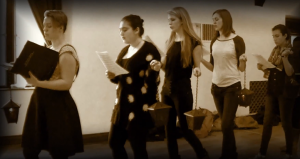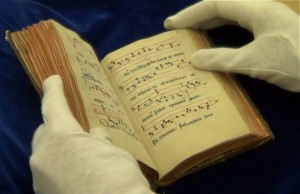This website examines a late Gothic, French processional (c. 1450-1500), which was probably held by the aristocratic, Dominican convent of Saint-Louis at Poissy. The manuscript contains Latin texts with accompanying rubrics and chant notation. It is a small, personal prayerbook (134 x 91 mm/5.3 x 3.6 inches), which probably belonged to a single woman, and it may have been copied or revised at the same convent where it was kept and used.
Although the manuscript now sits on a shelf in Bryn Mawr College’s Special Collections, it was once essential to the spiritual life of a flourishing house, where it would have facilitated and participated in the complex services and rituals whose sights, sounds, and motions are recorded in its texts. Even today, more than five centuries after its creation and two centuries after the destruction of its convent, the book preserves – in its subtle and idiosyncratic organization of language, in its carefully orchestrated transmission of word and chant, and in its very material structure – the echoes of medieval voices. It bears witness to the continuities of linguistic, musical, and spiritual traditions, as well as to the physical and intellectual interventions that attest to its long and active life.
This website seeks to reanimate the processional for students of the Middle Ages, of medieval music, and of manuscript studies by opening it up to close examination and to thoughtful reimagining. The entire book is available in a digital reader that is a linked to a full transcription of the Latin prayers, so that its Gothic script and abbreviations will be entirely accessible to beginning students of medieval Latin and paleography. The site also provides a recording of the first procession, the Candlemas service, sung by women of the Chamber Singers of Bryn Mawr and Haverford Colleges and the Bryn Mawr Renaissance Choir, under the direction of Haverford College’s Prof. Thomas Lloyd. A brief student-created documentary reviews the process of recording the chants and allows several of the project’s contributors to reflect on the history and meaning of the book and of its digital home. Finally, short essays expand on several facets of the manuscript’s structure and historical context, and a bibliography guides visitors in further research.
Although the site aims to make the book as accessible as possible and to suggest some of the intellectual and sensory environments that it would once have shaped, the digital platform can not recreate the experience of holding and reading the manuscript itself. Visitors are welcome to see the processional in person in Bryn Mawr College Special Collections. Please email SpecColl@brynmawr.edu to make an appointment. Further campus holdings are listed on the Rare Books, Manuscripts, and Archives webpage. Comments or questions about the site are welcome. Please address inquiries to Nava Streiter, nstreiter@brynmawr.edu

Members of the choir sing the Candlemas procession in Goodhart Hall with Bryn Mawr College class lanterns for candles.
Acknowledgements:
This project was designed and directed by Marianne Hansen (Bryn Mawr College, Curator and Academic Liaison for Rare Books and Manuscripts) and Nava Streiter (Bryn Mawr College, History of Art, PhD Candidate), who also researched the manuscript and wrote the web texts as part of a Graduate Assistantship in Bryn Mawr College Special Collections. The site is a testament to the talent and generosity of the Tri-Co community, whose members lent it their time, expertise, excitement, and good humor. It owes a particular debt to the following individuals and organizations:
Prof. Richard Freedman (Haverford College, Music) and Prof. Alicia Walker (Bryn Mawr College, History of Art), who guided the logistical and intellectual development of the project through many stages;
Prof. Thomas Lloyd (Haverford College, Music), who coordinated and conducted the recording of the Candlemas procession, which was performed by members of The Chamber Singers of Bryn Mawr and Haverford Colleges and The Bryn Mawr Renaissance Choir, and John Bailey (Musical Director, Bryn Mawr Renaissance Choir), who transcribed the music into modern notation and advised on the performance;
Eunice Alexander, Shana Burstein, Allie DiTucci, Emily Drummond, Jo Dutilloy, Maria de J. Ellis, Stefanie Feldman, Isabel Gross, Zubin Hill, Jane Hulting, Julia Lin, Hannah Nacheman, Carolyn Poutasse, Joelle Schindler, Abigail Stephenson, Anne Stokes Hochberg, Anna Swartzentruber, Joanna Wieckowski, and Hannah Weissmann, who sang in the choir;
Kyra Neiman (Bryn Mawr College, 2017), who directed and edited the documentary about the choral recording;
Calla Carter (Bryn Mawr College, 2018) and Connor Cassidy (Haverford College, 2017), who constructed the website, in consultation with Bryn Mawr’s Digital Collections Librarian, Rachel Appel;
Luca D’Anselmi (Bryn Mawr College, Classics, PhD Candidate), who transcribed the manuscript’s Latin texts;
Special Collections student employee, Kendall Baller (Bryn Mawr College, 2016), who scanned and edited the images of manuscript;
Grace Garrett (Bryn Mawr College, 2018), who researched its music and was instrumental in coordinating the choral recording and short film.
We are very grateful to the Tri-Co Digital Humanities Initiative, which substantially funded the creation of the website.
The site received the Delaware Valley Medieval Association’s Digital Project Prize for the 2015-16 academic year.
